We are in a prime marine-animal spotting location...or so we've been told. But since we've been gallivanting along the shores of northern Scotland, I've spotted exactly 2 seals: One feasting on a giant fish near Wick, and another bobbing in the loch near Dornoch. And zero dolphins to be seen anywhere, even in what is considered to be a prime spot near Cromarty.
So, today we were hopeful that the Scottish Dolphin Center on the northern coast would delight us with some dolphin sightings. But the only dolphin that we spied there can be seen here with Marty.
But, I wouldn't say that it was complete bust. The center is located on Spey Bay and the Moray Firth, and the area is quite unique as it has what is called a "shingle formation". Instead of sand dunes, there are rock dunes.
Rocks of every size, smoothed by the surf, tossed about along the shore. I'd never seen anything like it, and I do have to say that it was quite a challenge climbing up those rocks to get to the top so that we could search for dolphins.
Don't let those blue skies fool you. It might have been sunny, but with wind gusts up to 24 mph, it was by no means warm. But we were both prepared for the chill in the air, so that didn't keep us from attempting to spot a dolphin.
If we had seen a dolphin, it would apparently have been much larger than those that we see in the United States. Since the water temperatures are so much colder due to being so far north, the dolphins here have more blubber to help keep them warm, so they appear much more rotund. But, we'll really never know, will we?
The center itself is located in a building that was once a huge fishery. There are three ice houses that stand next to it, that would have been used to keep the fish cold.
And, there are several small houses located next to the building that would have been houses for the fisherman who worked there. Unfortunately, no more fishing occurs at this spot, so the buildings have been repurposed. (or would that be porpoised?)
There are several murals that are inlaid into the ground, using many of the stones found on the beach. Here are two of them:
The distillery represents the many such companies that are in abundance in this area. They are the famous Speyside whiskies, and we had toured that area several years ago, but never made it this far north until now.
As you can see, Marty enjoyed the visit, despite not seeing any dolphins.
Our next planned adventure for the day was to visit Duff House, which is a bit east of Portsoy, where we are staying. We decided to drive the coastal route which took us through quaint fishing villages along the way. Each one had its own startling beauty, and with the beautiful sky above us, it was quite an experiencing driving through each of them.
The coastal route took a bit longer, so we arrived at Duff house just before 1:00 pm. And, apparently, just when it was lunchtime for the staff. And, we were told, that the house would close for an hour. This came as a bit of a surprise, since nowhere on the website or information board does it say that the house closes for an hour for lunch. We were lucky we arrived when we did, or we would have presumed it was just closed for the day for some reason.
But, we used the time to our advantage and walked into Banff to explore a bit.
It really was a charming village with a lovely view of the harbor as well.
This last photo was taken from the Bridge Restaurant, that had a lovely view of the harbor as well as the bridge in the previous photo. We stopped in for a bit of refreshment and enjoyed the views.
We then made the hike back to Duff House.
The original plans called for a Georgian townhouse to be built on this estate by William Adam, the architect. He was based in South Queensferry, but was commissioned by William Duff who later became the first earl of Fife.
Work began in 1735, but Adam's grandiose plans began to add up in expenses, and Duff became quite annoyed by the escalating costs. He refused to continue to pay Adam, so all work on the house was stopped in 1741, while the two men squabbled over payment.
Adam died shortly after it was determine by the courts that Duff owed him the spent funds. He was never paid, and the house passed to future Duff family generations to complete it.
When Alexander Duff, the sixth earl of Fife married Queen Victoria's granddaughter, the family felt that they no longer needed Duff house, so they gifted it to the towns of Banff and Macduff in 1907. All of the personal items were removed so that the interior once again stood empty. But, it would eventually become a hotel, sanatorium, and a hotel once again. During WWII, it was used as an interment camp, POW camp, and HQ for Allied regiments. It came under attack during a German bombing raid in 1940, and sustained damage to one of the wings.
In 1950, it was placed under the care of Historic Environment Scotland who then researched the history of the house and the family, and painstakingly went about returning the interior to its original glory. They had photographs from the time that the Erskine family lived in the house prior to 1907, that were used as a basis for the present day decor. Only three original items were retained.
The sixth earl had several children, but all died without an heir. His youngest daughter, Margaret, had the foresight to will all of her family possessions to Duff house to be preserved there for future generations, so these are the items that one now sees while touring the house. The house is also used as a showcase for famous art on loan as well.
The tour began in a large drawing room delicately painted with pink walls and an elaborate ceiling that had been preserved all these years. I enjoyed the painting featuring this lovely woman although I cannot say who it is.
This mirror is one of the original items from the house, purchased by Lady Erskine. Note the lovely Wedgewood piece that enhances the fireplace.
There are two globes here: one representing earth and the other the heavens.
The house featured some exquisite chandeliers.
and so many intriguing paintings.
I tried to have some fun with mirrors
This set of paintings was interesting. They were originally a single painting. Someone must have decided to modify them sometime down the line.
And this painting is of the Erskine family whose youngest daughter, Margaret, gifted the contents of her home to fill Duff house when she passed.
Such fascinating stories, and so many interesting items to admire.
We really did enjoy our tour and were happy that we had decided to return later in the day.
From here, we drove into Portsoy, which is near our B&B. The sun had decided to stay out this time, although there was quite a wind whipping.
The views were stunning.
We walked from our B&B to dinner at the Station hotel Restaurant. Across the street stood this church with a lovely clock tower
and an unusual WWI memorial statue out front.
After dinner, we stopped next door for some Portsoy Ice Cream.
It was delicious!
I leave you with our most exciting dolphin moment of the day!
I'd say that was just about the perfect day, don't you think?
Until tomorrow.

































































































